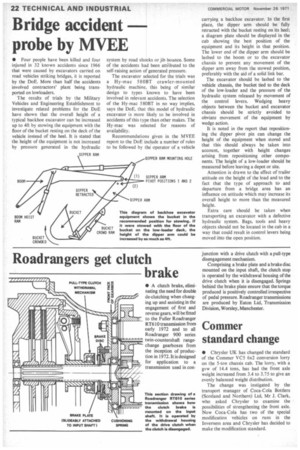Bridge accident probe by MVEE
Page 22

If you've noticed an error in this article please click here to report it so we can fix it.
• Four people have been killed and four injured in 32 known accidents since 1966 that were caused by excavators carried on road vehicles striking bridges, it is reported by the DoE. More than half the accidents involved contractors' plant being transported on lowloaders.
The results of trials by the Military Vehicles and Engineering Establishment to investigate related problems for the DoE have shown that the overall height of a typical backhoe excavator can be increased up to 41t by stowing the equipment with the floor of the bucket resting on the deck of the vehicle instead of the heel. It is stated that the height of the equipment is not increased by pressure generated in the hydraulic system by road shocks or jib bounce. Some of the accidents had been attiibuted to the self-raising action of generated pressure.
The excavator selected for the trials was a Hy-mac 580BT crawler-mounted hydraulic machine, this being of similar design to types known to have been involved in relevant accidents. The selection of the Hy-mac 5 SOBT in no way implies, says the DoE, that this model of hydraulic excavator is more likely to be involved in accidents of this type than other makes. The Hy-mac was selected for reasons of availability.
Recommendations given in the MVEE report to the DoE include a number of rules to be followed by the operator of a vehicle carrying a backhoe excavator. In the first place, the dipper arm should be fully retracted with the bucket resting on its heel; a diagram plate should be displayed in the cab showing the best position of the equipment and its height in that position. The lower end of the dipper arm should be lashed to the boom or to the excavator chassis to prevent any movement of the dipper arm away from the stowed position, preferably with the aid of a solid link bar.
The excavator should be lashed to the vehicle chassis, the bucket tied to the deck of the low-loader and the pressure of the hydraulic system released by movement of the control levers. Wedging heavy objects between the bucket and excavator chassis should be strictly avoided to obviate movement of the equipment by wedge action.
It is noted in the report that repositioning the dipper pivot pin can change the height of the equipment when stored and that this should always be taken into account, together with height changes arising from repositioning other components. The height of a low-loader should be measured before leaving a depot or site.
Attention is drawn to the effect of trailer attitude on the height of the load and to the fact that the type of approach to and departure from a bridge area has an influence on attitude which may increase its overall height to more than the measured height.
Extra care should be taken when transporting an excavator with a defective hydraulic system. Bags, tools and heavy objects should not be located in the cab in a way that could result in control levers being moved into the open position.


















































































